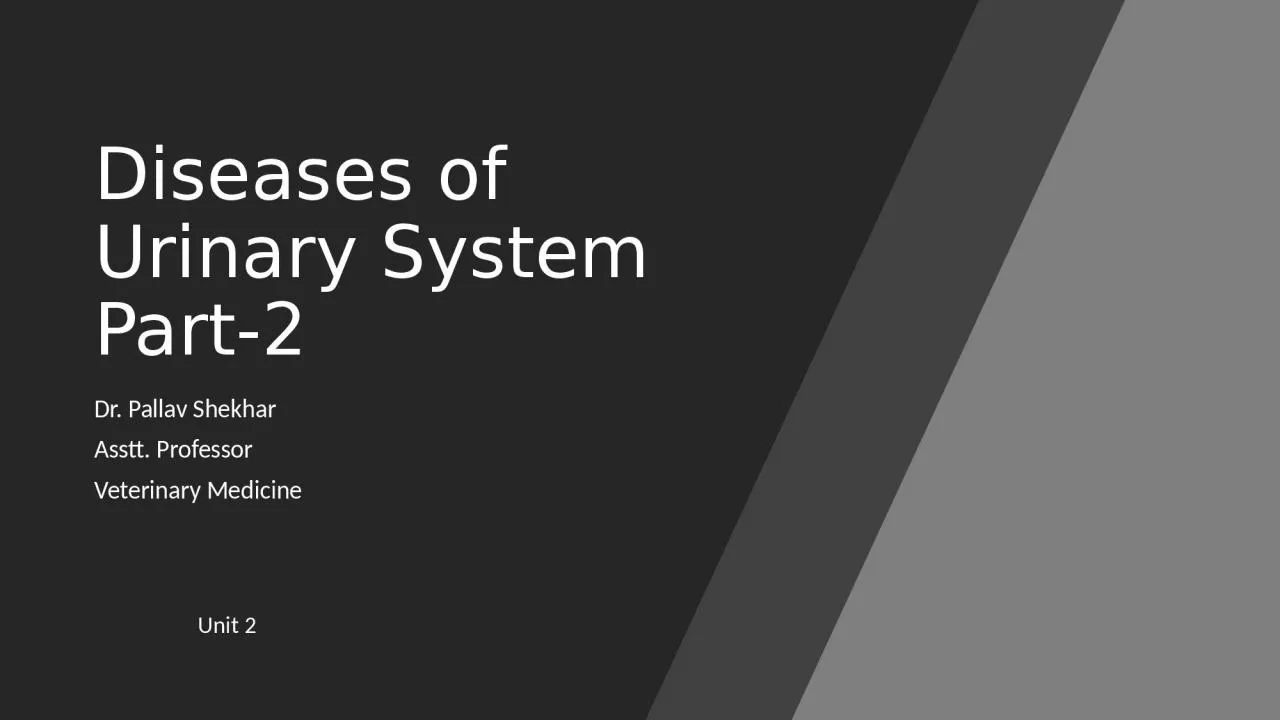

Dr Pallav Shekhar Asstt Professor Veterinary Medicine Unit 2 Acute Renal Failure ARF Acute renal failure ARF is by sudden onset of filtration failure by the kidneys accumulation of uremic toxins and dysregulation of fluid electrolyte and acidbase balance It is potentially ID: 929443
Download Presentation The PPT/PDF document "Diseases of Urinary System Part-2" is the property of its rightful owner. Permission is granted to download and print the materials on this web site for personal, non-commercial use only, and to display it on your personal computer provided you do not modify the materials and that you retain all copyright notices contained in the materials. By downloading content from our website, you accept the terms of this agreement.
Slide1
Diseases of Urinary System Part-2
Dr.
Pallav
Shekhar
Asstt. ProfessorVeterinary Medicine
Unit 2
Slide2Acute Renal Failure (ARF)
Acute renal failure (ARF) is by sudden onset of filtration failure by the kidneys, accumulation of uremic toxins, and dysregulation of fluid, electrolyte, and acid–base balance. It is potentially reversible if diagnosed quickly and treated aggressively.
Slide3Etiology
ShockMalignant hypertensionHeart failure, thromboembolism HeatstrokeExcessive vasoconstriction (e.g., administration of nonsteroidal anti-inflammatory drug [NSAID])Excessive vasodilation (e.g., administration of angiotensin-converting enzyme [ACE] inhibitor or antihypertensive drug)Prolonged anaesthesia Administration of antimicrobials Aminoglycoside Sulfonamide CephalosporinAmphotericin BChemotherapeutic agent (e.g., cisplatin and doxorubicin)Thiacetarsamide NSAIDs
Radiographic contrast agentsEthylene glycolHeavy metals (e.g., lead, mercury, arsenic, and thallium)Insect or snake venomHeme pigmentCalcium Leptospirosis Immune-mediated glomerulonephritis and arteritis Septicemia DICHepatic failure Heat strokeTransfusion reactionBacterial endocarditis Pyelonephritis Cortical necrosisLymphosarcoma
Slide4Clinical signs
Sudden onset of anorexia
Listlessness
Vomiting (± blood)
diarrhea (± blood)
Halitosis
Ataxia
Seizures
Oliguria/anuria or polyuria
Slide5Diagnosis
Clinical signs
Normal or high PCV Variable leukocytosis Elevated BUN, creatinine, and phosphate, potassium and glucoseLow bicarbonate and calcium Inability to concentrate urine.
Slide6Treatment
Discontinuation of nephrotoxic drugs
Treatment of etiology Maintenance hemodynamic stability Peritoneal dialysis and hemodialysis.
Slide7Fig Procedure of Peritoneal Dialysis
Slide8Slide9Chronic Renal failure
Slide10Etiology
Glomerulonephritis (e.g., autoimmune) amyloidosis intoxications
Hypoxia (anaesthesia-surgery) Intoxications (e.g.,heavy metals)Viral infections chronic subclinical leptospirosis Pyelonephritis focal nephritisMany congenital disorders (e.g., renal dysplasia, amyloidosis)
Slide11Clinical signs
Polyuria-polydipsia
Weight loss
Anorexia
vomiting
Anaemia
Foul smelling urine (Pyourea) – pyelonephritis.
Frequent micturation
straining during urination i.e. “stranguria”,
Red urine (haematuria),
Slide12Diagnosis
Anuria, polyuria, abnormal constituents, urinary colic, dysuria.
Urine analysis :
Pyuria, Proteinuria, microscopic examination reveals presence of epithelial casts cells.Serum biochemistry – BUN, serum creatinine
Culture of urine.
USG: Chronic renal failure Shrinkage of kidney
Kidney appear small K/a “End stage kidney”
Slide13Slide14TreatmentA protein-restricted kidney diet, phosphate restriction is beneficial, sodium restriction and alkalinization, increasing the dietary ω3: ω6 fatty acid ratio and active Vitamin D (calcitriol) and phosphate binders added to feed, Erythropoietin and blood transfusion.General Treatment :Antibiotics for 2-4 weeksSupportive & Symptomatic Urinary alkalizers to change pH.Use of diuretics e g. Frusemide @ 1 mg/kg I/M
Parenteral @ complex may be given.Antacids in case of gastritis due uremiaEg. Ranitidine @ 1-2 mg/kg IV or P.O.
Slide15Nephrosis
:
Nephrosis is degenerative and inflammatory lesions primarily affecting renal tubules. Nephritis means inflammation of kidney
It may occurs due to renal ischemia or due to toxic insult to
kindney
Slide16Nephrosis-Ischemia
Slide17ClassificationEmbolic Nephritis
Slide18Slide19Etiology:
It is considered as an autoimmune disease, E.coli, streptococci, ICH virus, Dirofilaria immitis (Heart worm) may acts as antigen..
Slide20Interstitial nephritis:
It means inflammation of interstitial tissue of kidney.
It is very common in dog and rare in other animal.
It may be acute or chronic in nature.
Etiology:
Bacteria : E.coli, Leptospira canilcola icterohaemorrhagica.
Virus – ICH (adenovirus).
Parasites Dictyophyema renale (kidney worm).
Toxins – Lead, Arsenic, Mercury.
Drugs sulphomamide , Paracetamol. Kidney parenchyma indorgo inflammatory changes which blocks the tubules together that is cellulr infiltration.
Slide21Pyelonephritis :
It means inflammation of renal parenchyma &
pelivis. It is highly fatal pyogenic inflammation of renal pelvis and parenchyma normally due to ascending infection with bacteria.It is chronic supportive inflammation of kidney.It is common in cows but has been recorded in sheep, goat, horses, buffalo, dog. It is common in recently asteriated and advanced pregnant animals/female.Etiology :Specific causes : Cerynobacterium renale (most common ) and E.coli in cattle. Eubacterium suis in pig.Ascending infections from lower urinary tract infection or genital tract is the most common way of infection.e.g. Metritis, vaginitis, cystitis, orchitis . Infection by hematogenous route e.g. septicemia caused by Pseudomonas aeruginosa may also occur).
Slide22Embolic nephritis
Inflammation of kidney due to emboli
Emboli may originate from localized septic process :
Valvular endocarditis in all spp.
Suppurative lesions in uterus, udder,
navalnegia
or peritoneal cavity in cattle.
Embolic associated with systemic infection
Septicemia in neonatal animals, shigellosis it foals,
colibacilosis
, salmonellosis.
Erysipelas in pig.
Septicemic strangles in horses.
Slide23Ureteritis and UrethritisInflammation of ureter and urethra It is characterized by abdominal pain, scanty turbid urine and painful urination.Etiology: Corynebacterium renale, E. coli, Staphylococcus sp, Proteus spClinical signs: Abdominal pain, dysuria, Animals remain in urinary posture after cessation of urine for long, Straining during urination.Treatment: Similar to cystitis
Slide24Cystitis: Inflammation of urinary bladder is called as cystitis.Etiology :Trauma :Corrosive chemicals toxic substances, calculi, improper catheterisetion or direct injury. Bacteria :E.coli, corynebocutanium renale, Proteins spp. Infection may be
(a) Ascending – from urethra or genital tract.(b) Decending – from suppurative nephritis.Infection is mostly ascending type Urine is (favours microbial growth ) Urolithiasis (Calculi, neoplasm, stricture of urethra, dystokia), Prolapse of uterus.
Slide25Urolithiasis:The presence of calculi in the urinary system is referred to as urolithiasis.Calculi may be present in kidney tubules, pelvis, ureter, bladder or urethera.It is more common in male and in ruminant more in castrated males ( bullock) at the sigmoid flexure. In canine it is more common in UB.
Clinical Findings: Severe pain, Stiff gait, grunting at urination, hydronephrosis and UremiaTreatment: Correction of obstruction by urethrotomy, cystotomy or ureterotomy Ruminants: feeding of NaCl, ammonium chloride (10g/sheep).Dog: Change of Urinary pH